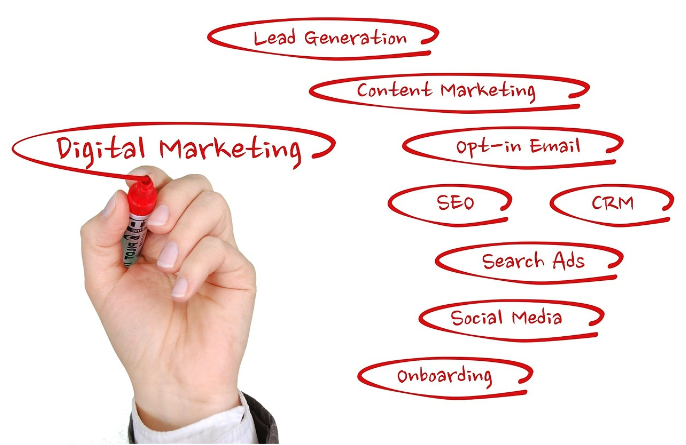Digital marketing has revolutionized the way companies reach and engage with their target audience. With the rise of the internet and various digital channels, businesses now have a plethora of tools and strategies at their disposal to promote their brand, products, and services. In this comprehensive guide, we will explore the world of digital marketing, its various components, and how it can benefit your business.

Understanding Digital Marketing
Defining Digital Marketing
Digital marketing is the practice of utilizing digital channels, such as websites, social media, search engines, and mobile devices, to connect with potential customers and promote products or services. It encompasses a wide range of strategies and tactics that aim to increase brand visibility, drive traffic, and generate leads or sales.
In today’s digital age, having a strong online presence is crucial for businesses of all sizes. With billions of people using the internet and various digital platforms, digital marketing provides a cost-effective way to reach a vast audience and engage with them on a more personal level.
The Importance of Digital Marketing
Digital marketing has become increasingly important due to the widespread adoption of the internet and mobile devices. According to recent statistics, a significant percentage of the global population is online daily, making it a prime opportunity for businesses to connect with their target audience.
One of the key advantages of digital marketing is its ability to target specific demographics and track the effectiveness of marketing campaigns. Unlike traditional marketing methods, digital marketing allows businesses to measure metrics such as website traffic, engagement rates, and conversion rates, providing valuable insights for future optimization.
Digital Marketing vs. Traditional Marketing
While traditional marketing methods such as print, television, and radio advertising still have their place, digital marketing offers unique advantages that make it a preferred choice for many businesses. Here are some key differences between digital marketing and traditional marketing:
- Cost-effectiveness: Digital marketing often requires lower upfront costs compared to traditional marketing channels. For example, running a pay-per-click (PPC) advertising campaign on search engines can be more cost-effective than placing ads in print publications.
- Targeting capabilities: Digital marketing allows businesses to target specific demographics, interests, and behaviors, ensuring that their message reaches the right audience. Traditional marketing methods often have a broader reach but may not be as targeted.
- Measurability and analytics: With digital marketing, businesses can track and measure the performance of their campaigns in real-time. Metrics such as website traffic, click-through rates, and conversion rates provide valuable insights that can guide marketing strategies. Traditional marketing methods often lack this level of measurability.
- Interactivity and engagement: Digital marketing offers interactive features such as social media engagement, live chats, and personalized content, fostering a deeper connection between businesses and their audience. Traditional marketing methods are more one-way communication channels.
Key Components of Digital Marketing
Digital marketing encompasses various components, each serving a specific purpose in reaching and engaging with the target audience. Let’s explore some of the key components of digital marketing:
Search Engine Optimization (SEO)
Search Engine Optimization, or SEO, is the practice of optimizing a website to rank higher in search engine results pages (SERPs). By improving the visibility and organic ranking of a website, businesses can attract more relevant traffic and increase their chances of converting visitors into customers.
Effective SEO involves optimizing various on-page and off-page elements, including keyword research, content creation, backlink building, and technical website optimization. By aligning with search engine algorithms and user intent, businesses can improve their online visibility and drive targeted organic traffic.
Content Marketing
Content marketing focuses on creating and distributing valuable, relevant, and consistent content to attract and engage a target audience. It involves various formats such as blog posts, articles, videos, infographics, and ebooks, designed to educate, entertain, or inspire the audience.
The goal of content marketing is to build brand awareness, establish thought leadership, and nurture relationships with potential customers. By providing valuable content, businesses can position themselves as trusted sources of information and encourage audience engagement and loyalty.
Social Media Marketing
Social media marketing leverages social media platforms such as Facebook, Instagram, Twitter, and LinkedIn to promote a brand, engage with the target audience, and drive website traffic or conversions. It involves creating compelling content, running targeted ads, and engaging with users through comments, messages, and shares.
Social media marketing allows businesses to build a community, increase brand visibility, and foster customer relationships. It provides a platform for sharing updates, promotions, and valuable content, ultimately driving engagement and encouraging brand advocacy.
Pay-Per-Click (PPC) Advertising
Pay-per-click advertising is a form of digital advertising where businesses pay a fee each time their ads are clicked. It involves bidding on keywords and placing ads in search engine results or on relevant websites and platforms. The most common platform for PPC advertising is Google Ads.
PPC advertising offers businesses the opportunity to reach a highly targeted audience and drive immediate results. By carefully selecting keywords, optimizing ad copy, and monitoring performance, businesses can maximize their return on investment (ROI) and achieve their marketing goals.
Email Marketing
Email marketing involves sending targeted messages and promotional content to a list of subscribers who have opted in to receive communications from a business. It is an effective way to nurture leads, build customer relationships, and drive conversions.
Effective email marketing involves segmenting the audience, personalizing messages, and providing valuable content or exclusive offers. By delivering relevant and engaging emails, businesses can increase open rates, click-through rates, and ultimately, their conversion rates.
Influencer Marketing
Influencer marketing leverages the popularity and influence of individuals or content creators in specific niches to promote a brand or product. Businesses collaborate with influencers to create sponsored content, reviews, or endorsements, reaching the influencer’s audience and leveraging their trust and credibility.
Influencer marketing allows businesses to tap into the existing fan base and reach a highly engaged audience. By aligning with influencers whose values and target audience align with their brand, businesses can increase brand awareness, drive traffic, and boost sales.
Video Marketing
Video marketing involves creating and promoting video content to engage, educate, or entertain the target audience. It can take various forms, including product demos, tutorials, testimonials, vlogs, and brand storytelling.
Videos have become increasingly popular in digital marketing due to their high engagement and shareability. Platforms such as YouTube, Instagram, and TikTok provide opportunities for businesses to reach a wide audience and convey their brand message effectively.
Mobile Marketing
Mobile marketing focuses on targeting and engaging users on their mobile devices, such as smartphones and tablets. It involves strategies such as mobile-optimized websites, mobile apps, SMS marketing, and location-based advertising.
With the increasing use of mobile devices for internet browsing and online shopping, businesses need to ensure their digital marketing efforts are mobile-friendly. Mobile marketing allows businesses to reach users on-the-go and provide a seamless user experience across devices.
Digital Marketing Strategies
Creating a Digital Marketing Plan
Before diving into digital marketing tactics, it’s essential to create a comprehensive digital marketing plan. A digital marketing plan outlines the business’s marketing goals, target audience, key messaging, and strategies to be implemented.
The digital marketing plan should consider various factors, such as the competitive landscape, industry trends, and the target audience’s preferences and behaviors. It should align with the overall business objectives and provide a roadmap for executing effective digital marketing campaigns.
Targeting Your Audience
One of the key advantages of digital marketing is the ability to target specific audiences with precision. Understanding your target audience is crucial for developing effective marketing strategies and delivering personalized messages that resonate with them.
Market research, customer surveys, and data analysis can provide valuable insights into your target audience’s demographics, preferences, and behaviors. By segmenting your audience and tailoring your marketing efforts to specific segments, you can maximize the effectiveness of your campaigns and drive better results.
Measuring Success with Key Performance Indicators (KPIs)
Measuring the success of your digital marketing efforts is essential to understand what works and make data-driven decisions. Key Performance Indicators, or KPIs, are quantifiable metrics that help assess the performance and effectiveness of marketing campaigns.
Some common KPIs in digital marketing include website traffic, conversion rates, click-through rates, engagement rates, and return on investment (ROI). By regularly monitoring and analyzing these metrics, businesses can identify areas for improvement, optimize their strategies, and achieve their marketing goals more effectively.
The Challenges of Digital Marketing
Information Overload
With the rapid growth of digital channels, consumers are inundated with an overwhelming amount of information and advertisements. Standing out in a crowded digital landscape is a significant challenge for businesses.
To overcome information overload, businesses need to create compelling and relevant content that captures the attention of their target audience. Understanding the audience’s needs, preferences, and pain points can help businesses deliver valuable content that cuts through the noise and drives engagement.
Implicit Bias in Digital Marketing
Implicit bias, or unconscious bias, can inadvertently seep into digital marketing strategies and content. It occurs when marketers unknowingly hold biases that influence their decision-making and the way they target, represent, or exclude certain demographics.
To mitigate implicit bias, businesses should strive for diversity and inclusivity in their marketing strategies. This includes representing a diverse range of individuals in visual content, avoiding stereotypes, and conducting regular audits and assessments of marketing materials to ensure they are inclusive and representative of their target audience.
The Future of Digital Marketing
Emerging Trends
Digital marketing is a dynamic field that continues to evolve with new technologies and trends. Some emerging trends in digital marketing include:
- Artificial Intelligence (AI): AI technologies, such as chatbots and machine learning algorithms, are transforming the way businesses interact with customers and personalize their marketing efforts.
- Voice Search Optimization: With the rise of voice assistants like Siri and Alexa, optimizing content for voice search has become crucial. Businesses need to adapt their SEO strategies to account for voice-based queries and provide relevant answers.
- Video Content Dominance: Video content is becoming increasingly popular across digital platforms. Businesses should invest in creating high-quality video content to engage their audience and drive better results.
Artificial Intelligence (AI) in Digital Marketing
Artificial Intelligence (AI) is revolutionizing various aspects of digital marketing. AI-powered tools and algorithms can automate tasks, analyze vast amounts of data, and provide valuable insights for marketers. For example, AI can help identify patterns in consumer behavior, personalize content recommendations, and optimize advertising campaigns.
By leveraging AI technologies, businesses can streamline their marketing processes, enhance customer experiences, and make data-driven decisions to improve their overall marketing effectiveness.
Voice Search Optimization
Voice search is rapidly gaining popularity as more users rely on voice assistants to perform searches or complete tasks. Optimizing content for voice search involves understanding how people phrase their queries when speaking and creating content that aligns with those queries.
To optimize for voice search, businesses should focus on long-tail keywords, provide concise and direct answers, and ensure their website is mobile-friendly and loads quickly. Voice search optimization presents a valuable opportunity for businesses to capture voice-based traffic and provide seamless user experiences.
Conclusion
Digital marketing has transformed the way businesses connect with their target audience and promote their products and services. With a wide range of digital channels and strategies at their disposal, businesses can reach a vast audience, engage with them on a more personal level, and drive meaningful results.
Understanding the key components of digital marketing, developing effective strategies, and staying ahead of emerging trends are crucial for businesses to thrive in the digital landscape. By embracing digital marketing and adapting to the evolving consumer behaviors and preferences, businesses can unlock new opportunities for growth and success in the digital age.
